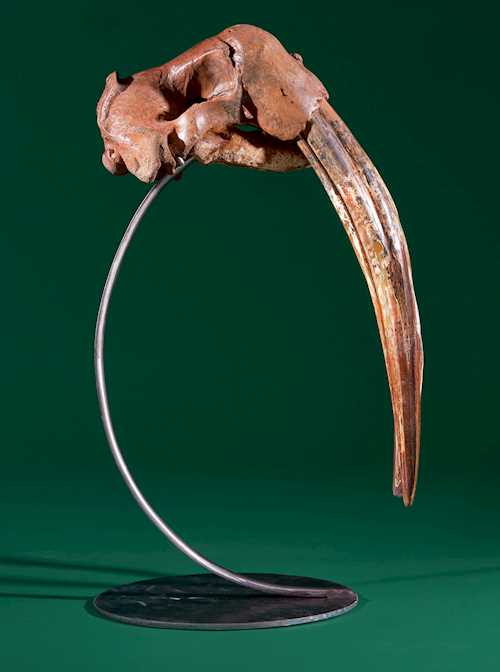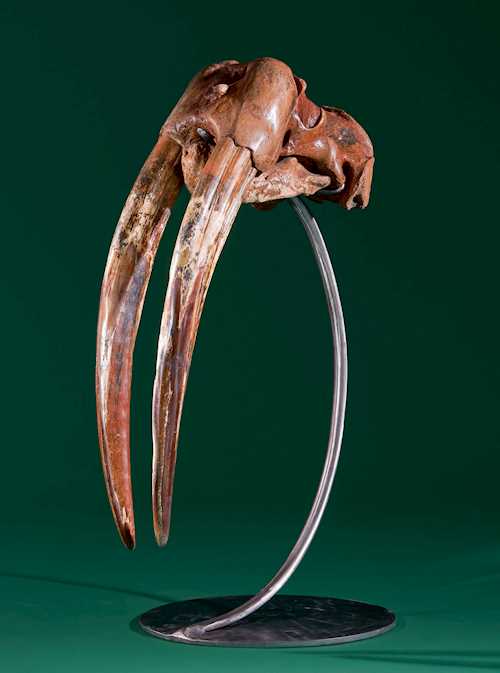
Lot 4017* - A211 Out of This World - mardi, 03. décembre 2024, 17h00
FOSSIL WALRUS SKULL
Odobenus rosmarus rosmarus
500 – 5000 years
Found in 1968
St. Lawrence Island, Alaska, USA
90 × 40 × 22 cm (measurements not including stand)
500 – 5000 years
Found in 1968
St. Lawrence Island, Alaska, USA
90 × 40 × 22 cm (measurements not including stand)
Provenance: US private collection
The walrus (Odobenus rosmarus) is a large marine mammal, which today lives near the North Pole in the Arctic Ocean and the subarctic seas of the northern hemisphere. The species is subdivided into two subspecies, the Atlantic walrus, the Odobenus rosmarus rosmarus, which lives in the Atlantic Ocean, and the Pacific walrus, Odobenus rosmarus divergens, which lives in the Pacific Ocean.
Odobenus, the ancestor of the only genus of walrus that still exists today, began to evolve during the middle Miocene (16–11 million years) in the North Pacific Ocean and diversified during the late Miocene (11–5 million years), dispersing to the North Atlantic Ocean by the early Pilocene (5–2.5 million years). This genus was first described by the legendary Carl von Linné, also known as Linnaeus, in his ground-breaking book ‘Systema Naturae’ in 1758.
Perhaps the most characteristic feature of these impressive animals is their pair of elongated, ever-growing upper canine tusks found in adults of both sexes. A fossil record reveals that these unique structures evolved in only this single lineage of walrus.
This evolution is associated with many other modifications of the skull and mandible, which resulted in the unique-looking animal we know today. Their impressive stature and robust skin not only keep them warm but also safe, and walrus can fight polar bears and even orcas successfully.
This inhabitant of the icy and raw landscapes of the North Pole also plays an important role in the religion and folklore of many Arctic peoples. Skin and bone are used in some ceremonies, and the animal appears frequently in legends – for example in a Chukchi myth of the old walrus-headed woman who rules the bottom of the sea, who is in turn linked to the Inuit goddess Sedna.
The specimen presented here is a complete and very well-preserved fossil skull of a walrus, which was found on St. Lawrence Island by a local ivory carver in 1968. Its beautiful long tusks are in formidable condition. It is a remnant of the evolution of this relict species and impresses not only with its aesthetics but also with its scientific value, helping us to understand the development of the marine fauna as we know it today.
The walrus (Odobenus rosmarus) is a large marine mammal, which today lives near the North Pole in the Arctic Ocean and the subarctic seas of the northern hemisphere. The species is subdivided into two subspecies, the Atlantic walrus, the Odobenus rosmarus rosmarus, which lives in the Atlantic Ocean, and the Pacific walrus, Odobenus rosmarus divergens, which lives in the Pacific Ocean.
Odobenus, the ancestor of the only genus of walrus that still exists today, began to evolve during the middle Miocene (16–11 million years) in the North Pacific Ocean and diversified during the late Miocene (11–5 million years), dispersing to the North Atlantic Ocean by the early Pilocene (5–2.5 million years). This genus was first described by the legendary Carl von Linné, also known as Linnaeus, in his ground-breaking book ‘Systema Naturae’ in 1758.
Perhaps the most characteristic feature of these impressive animals is their pair of elongated, ever-growing upper canine tusks found in adults of both sexes. A fossil record reveals that these unique structures evolved in only this single lineage of walrus.
This evolution is associated with many other modifications of the skull and mandible, which resulted in the unique-looking animal we know today. Their impressive stature and robust skin not only keep them warm but also safe, and walrus can fight polar bears and even orcas successfully.
This inhabitant of the icy and raw landscapes of the North Pole also plays an important role in the religion and folklore of many Arctic peoples. Skin and bone are used in some ceremonies, and the animal appears frequently in legends – for example in a Chukchi myth of the old walrus-headed woman who rules the bottom of the sea, who is in turn linked to the Inuit goddess Sedna.
The specimen presented here is a complete and very well-preserved fossil skull of a walrus, which was found on St. Lawrence Island by a local ivory carver in 1968. Its beautiful long tusks are in formidable condition. It is a remnant of the evolution of this relict species and impresses not only with its aesthetics but also with its scientific value, helping us to understand the development of the marine fauna as we know it today.
CHF 35 000 / 50 000 | (€ 36 080 / 51 550)





